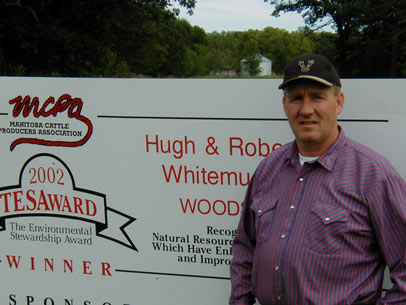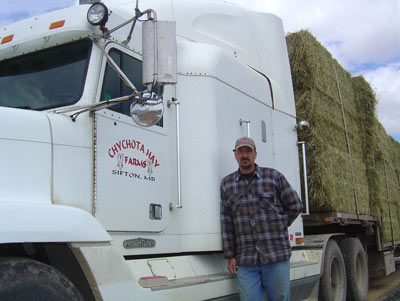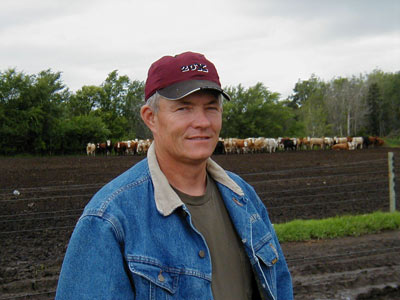Management Practices From the Best
This factsheet features four producers – two award-winning graziers and two hay experts – who are all highly successful at growing forage. Their stories can provide food for thought, or maybe even some ideas for your own operation. Read on to see what they have to say.
A quarter of a Century-Plus of Rotational Grazing
They started in 1978, and that makes Hugh and Robert Blair two of the most experienced rotational graziers in Manitoba. Along the way they helped found the Benchland Forage Group, the oldest grazing organization in the province, and they developed a pumping system that uses heat from the earth to help water animals on pasture in the winter. They also received the 2003 TESA (The Environmental Stewardship Award) from the Manitoba Cattle Producers Association for their work in riparian protection.
Hugh and Robert run a 400 pair cow-calf operation, with approximately 3,300 acres of tame and native forage, eight miles east of Gladstone on the Whitemud River. They have a total of five pastures, all divided into paddocks.
The biggest piece of advice Hugh can offer on rotational grazing is “don’t over-graze!” In a normal year, the Blairs keep the cattle from grazing until June 1, then put them on each paddock for about 11 days per paddock. The second time, they leave them on each paddock for about twice as long.
The science of this “twice-over” grazing is to use 25 per cent of the plant the first time, ensuring the seed head is grazed off to facilitate tillering and thickening. The second round of grazing should use 50 per cent of the plant, and it facilitates even more thickening. It’s something Hugh and Robert learned from a New Zealand grazing expert, and it really works, they say.
But the real art of grazing requires something more.
“The secret is to watch the plant,” said Hugh. “You must always be aware of the plant growth and also of the species.”
Their pastures are so lush that in times of bad drought, the Blairs have run out of water for their cattle before they ever run out of grass.
Using stockpiled forage from their lush pastures, they are able to extend the grazing season significantly. Using stockpiled alfalfa, they have another trademark practice that serves them well. The brothers wait until the plants wilt after the first frost, an indication they are dormant, and then they utilize the top growth – either by letting the cattle graze or by cutting it and feeding from the swath. Because the plants are dormant, they are not damaged.
The Blairs also use golden German millet for swath grazing, and later on, they move hay and silage out to pasture. Depending on conditions, the Blairs are often able to keep the herd on pasture until mid-January.
TESA Award

The Blair’s TESA award can be contributed to the water hemlock that was growing along the Whitemud River.
“I remember my father telling us that this was dangerous,” Hugh said. “It’s very poisonous – even a small amount can kill a large cow.”
To protect their cattle, the Blairs began to fence off small sections of the Whitemud so the herd didn’t have access to the river. They did a little more each year, mostly at their own expense, but a few times with funding from the Benchland Forage Group.
They liked the ecological improvements that began to occur along the protected banks, and they were relieved their cattle were safe, so they continued fencing. Eventually, they fenced all of their land adjacent to Squirrel and Pine creeks, too. The last big chunk, completed in 2002, was done with the help of the Manitoba Habitat Heritage Corporation, and now, there is no cattle access to any waterway on any of their land.
To bring water on pasture, Hugh and Robert invented a portable solar pump that takes water from the dugout or the river. A shallowly-buried pipeline runs it to the watering station.
In winter, the solar pump brings water from a deep well into a small, well-insulated building right on pasture. A 24-foot pipe brings up heat from the ground to keep the building warm and prevent the water from freezing, while a small opening allows the cattle to stick their heads in to drink.
“It works wonderfully,” Hugh said.
With a cutting edge watering system, a completed long-term fencing project, robust pastures and an environmental award under their belts, the question now is what Hugh and Robert will turn their expertise to next.
Self-Taught Alfalfa Hay Producers Find Success
The year that Murray and Clark Combs sowed their first alfalfa crop, they sold it to a trucker who was heading south – right on the spot the day it was baled. That was 1988, and they have never looked back. Along the way they’ve had some bumps in the road, but their selftaught efforts have, by and large, been very successful.
“Diversification was the big thing then,” said Murray. “We tried it and we liked it.”
The Combs brothers, who farm north of Deloraine, liked it so much that over the years they went from growing all grains to an operation that currently includes 900 acres of grain, 1,000 acres of alfalfa (either their own or custom baled) and 450 acres of grass hay.
They export the top 70 per cent of their alfalfa crop and use the remaining lower quality in their cow-calf operation (100 cows). Three hundred acres of grass hay, which was for the PMU market, will go into cereals for a few years and then into alfalfa. The remaining grass hay is still produced for the PMU market.
Murray and Clark took the plunge into forages because they wanted to maintain their acreage and their revenue, instead of having to increase their grain acreage for the same revenue – something that was just beginning to be a necessity at the time. Along the way, there have been many advantages, not the least of which is less inputs.
“Our input bill is less; once alfalfa and grass is established, you don’t need to seed and spray every year,” said Murray. “Our soil stays where it is, too, instead of blowing away.”
The Combs brothers are conscientious in maintaining their alfalfa stands, taking them out when they get old, re-planting them to cereals for a few years, and then re-planting to alfalfa.
They must be doing something right because if you want to buy hay from the Combs brothers, you’ll have to wait in line. They developed their client base using the hay list compiled by the Manitoba Forage Council from World Dairy Expo, and with only word-of-mouth advertising, they now have a waiting list of clients. In fact, they’ve had to pass the names of potential clients on to other producers.
Part of the Combs’s success can be attributed to their flexibility. They share equipment, and are willing to make a number of arrangements to run the custom-combining end of their operation. They do custom baling on a cash rent basis, on a per-pound of standing crop basis, or they will take the whole crop from cutting through to marketing.
First in Their Area
They have named the marketing arm of their operation Frontier Forage Services Ltd., and the name is fitting because Murray and Clark were the first producers in their area to get into the forage business. Even though they’ve experienced excellent success, Murray is quick to point out that they have made mistakes along the way because there was no one to learn from.
“We’ve learned some difficult lessons – including patience to let the crop dry sufficiently for maximum quality,” he said. “Also, in the beginning, we experienced losses because we didn’t protect the hay from the weather.”
Another thing they learned, says Murray, is to develop a market before undertaking any expansion because the shelf life of the product (alfalfa hay) is not as long as grain.
He is optimistic about the future of forage production in Manitoba, but he feels that Manitoba hay producers must look past the U.S. to sell their product. With the realities of bioterrorism regulations and protectionism, he is uneasy about relying too heavily on one market.
If Manitoba would grow more hay, its reputation would grow and opportunities would present themselves, he believes. However, it’s a Catch 22 situation, because it’s hard to get into something before there is a market. Additionally, it’s not the easiest of transitions because it takes more work, more timing and more marketing efforts to sell the crop.
Murray and Clark made that transition, and made it well, and now other producers in the area are getting into the hay business based on their example. Murray is pleased with the fact that they have met many hay producers since they got into the business, “good people,” many of whom have become good friends. He is also proud of contacts they have made in the U.S. dairy industry, people who trust them and their product. “It takes a great leap of faith on their part to pay almost double for Canadian hay because of the freight cost,” he said. “But they know us and they know we produce a good product, and they know it’s worth it.”
Is Hay Production for You?
Advantages
- A good option for diversification.
- Less inputs.
- Good residual effects of nitrogen in the soil if crop is taken out.
- Less acreage required than cereal for same income (better returns per acre).
- Protection from wind and water erosion.
- Spreads workload out over the entire growing season.
- Provides summer employment for older children.
- Potential for excellent returns.
Disadvantages
- Initial equipment investment is high.
- Steep learning curve; potential for mistakes.
- Ties up the entire summer.
- Long hours.
- Crop insurance currently does not address export alfalfa.
- Narrower window than grain for harvest.
- Low quality in poor growing years makes crop hard to sell.
- Need something to utilize lower quality end of crop each year.
Compiled by Murray Combsi>
Hog Manure and Timothy Are the Key for Former Grain Producer

Glenn Chychota used to run two feeder barns (4,200 head) with 1,300 acres of cereals – but that was before he put in a field of timothy for export back in 1995.
Now, he still runs two feeder barns, but he also operates Chychota Hay Farm, an enterprise with 880 acres of timothy (including rented land) and a planned 145 acres of forages. He has no cereals to speak of, and he is co-owner of Intermountain Forage Limited, a forageprocessing enterprise that compacts hay for export. Customers include local hay producers, as well as hay makers from around the province.
Almost all of Glenn’s timothy crop goes to the export market, but anything that is lower in quality is sold to the domestic market or used in his own 50-head cow-calf operation. He has also recently added a second baler to his operation, and is doing custom baling for processing plant customers and others.
Initially, Glenn saw timothy as a way to use the manure his operation was producing, but he quickly saw the advantages of producing hay. Prices were good for export timothy, and the only equipment he needed to invest in was a baler. On the other hand, his equipment for cereal production was aging, and he was looking at having to replace it.
Economics were such that if he wanted to stay in cereals, he would have had to buy more land, too, in order to get the same amount of money out of his operation.
“I could pursue hay with the same acreage as cereals,” he said, and so he sold his combine, his air seeder, and some grain land, to boot. He has never regretted it because he has found the right fit.
The manure Glenn applies has a lot to do with growing an export-quality crop. He fall applies it at rates that give him 70 to 80 pounds of nitrogen per acre, and the difference over fields without manure applications is remarkable. The hay “has a good jump” in spring, and yields are better – up to one tonne per acre more, he says.
But timothy production has its share of headaches, too. The weather, of course, can prevent the hay from adequately drying down for processing, although the plant has installed dryers to help address this problem. Quack grass, too, has been a big problem in older fields, and Glenn has found he must rotate the timothy out in order to control it. He had to put a number of timothy fields into cereals for a few years, but there is no question that he will re-seed back to hay.
“I wouldn’t go back into grain farming,” he said. “If the Japanese market disappears, we’ll have to find another one.”
Grazier of the Year Shares Tips

Why was Wayne Gardiner named the Manitoba Grazing School’s 2003 Grazier of the year? It wasn’t just his extended grazing season, but also his exceptionally healthy pastures and his environmental stewardship that clinched the award for him. Read on as Wayne shares his thoughts on these topics from his farm at Lakeland, north of Portage la Prairie.
To start with, Wayne has extended his grazing season so that his 375 (approximately) cow-calf pairs can graze long into the fall. He first uses stockpiled forage he has set aside for this purpose – a tall fescue, alfalfa and meadow brome mix. The fescue holds its feed value well in the fall, he says, and it can also be grazed in early July and still produces excellent re-growth.
Tall fescue is also very palatable after frost, and cows will eat through the snow to get to it, Wayne adds. By the time the snow gets heavy, the calves are gone and the cows manage quite well.
From fall grazing, Wayne keeps the herd on pasture by using swath grazing until Christmas. He has had excellent results with oats, barley, and golden German millet, and he sometimes uses standing Canamaize if feed costs are low. If they are high, he will put the Canamaize into silage to prevent waste.
In January, Wayne feeds corn or hay silage right on pasture, and keeps the herd out until February. They come in for calving until early April, and then he returns them back to pasture for more silage until the spring growth comes in.
Because he depends so heavily on his pastures for many months of the year, Wayne is very particular about preserving them. For this reason, he uses rotational grazing on 90 per cent of them.
“That’s what keeps them so healthy,” he said. “Some of these pastures are 18 to 19 years old and still going strong.”
Wayne has three pastures of tame forage with six or eight paddocks per pasture. He grazes each paddock for no more than a week and allows a 35-day rest period after grazing. His largest pasture, a rented eight quarters, is all native grasses and he practices the same rotation.
He says it doesn’t pay to fertilize the native pastures, but that fertilizing the others every two to three years is a must to improve longevity. Phosphate is the most important nutrient, which Wayne applies at a rate of 30 lbs per acre, but he also applies potash at 30 pounds per acre and sulphur at 10 lbs per acre.
Because his herd is constantly on the move, manure is spread around his entire land base. Build-up is kept to a minimum in the yard and the corrals because animals are only there for two months. And that’s where the environmental stewardship comes in.
“If you move cows, you move nutrients,” said Wayne. “You give wildlife a chance, too.”
For More Information
- Your local Manitoba Agriculture, Food and Rural Initiatives GO office
- Foragebeef Website: A forage and beef production website that contains information gathered from Manitoba, Alberta and Saskatchewan.
You Can Help Reduce Greenhouse Gas
Feeding animals more high-quality forage can help reduce their production of methane gas, one of the components of greenhouse gas. In addition, healthy pastures and crops can help sequester (absorb) carbon, another component of greenhouse gas. For more information on greenhouse gas, and how livestock producers can do their part to help reduce it, visit the following website.
- Canadian Cattleman’s Association: www.cattle.ca
This information is posted with permission. The following agencies worked collaboratively and provided funding support for this publication:
- Manitoba Agriculture, Food and Rural Initiatives
- Agriculture and Agri-Food Canada
- Manitoba Forage Council
Partial funding for this publication was provided by the Greencover Canada Program, a five-year, $110-million Government of Canada initiative designed to help producers improve grassland-management practices, protect water quality, reduce greenhouse gas emissions, and enhance biodiversity and wildlife habitat.
For further information on Greencover Canada, please visit www.agr.gc.ca/env/greencover-verdir or phone 1 866 844-5620.

